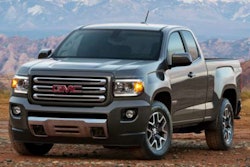
Peterbilt demonstrated its autonomous vehicle, a Model 579 concept truck, this week at the ITS World Congress in Detroit.
Peterbilt’s entry into the autonomous vehicle arena.Peterbilt’s Bill Kahn, the company’s principal engineer, said the systems to develop self-driving trucks already exist, and that future autonomous vehicles will be extensions of those systems.
“The vehicle we demonstrated during the ITS World Congress showcases how these technologies can integrate to provide the next generation of advanced cruise control and automation features. Heavy-duty trucks are an ideal platform for automated operation because, compared to motorists, commercial vehicles travel a majority of their miles on modern highways, at constant speeds and for extended periods of time.”
Kahn noted the automation technologies are not driver replacement tools but rather complement the truck operator.
“Improving safety, efficiency and performance are top priorities for the entire transportation industry. These are common goals we are collectively working toward,” Kahn said.
Among the existing technologies utilized by the vehicle are:
· Radar-based adaptive cruise control (ACC) that automatically accelerates and decelerates to maintain safe following distances.
· Lane departure warning systems (LDWS), which use cameras to detect lane edges and striping and alerts the driver if the vehicle is drifting outside of its lane.
Kahn said the performance of these technologies is boosted by giving the LDWS the ability to self-correct the vehicle through integration with the electronically controlled steering system and the ACC the ability to use the cameras to bring the vehicle to a complete stop, if necessary.
Additionally, the Model 579 autonomous concept truck uses a GPS system to add features such as last mile routing, parking assist and new driver proficiency.








